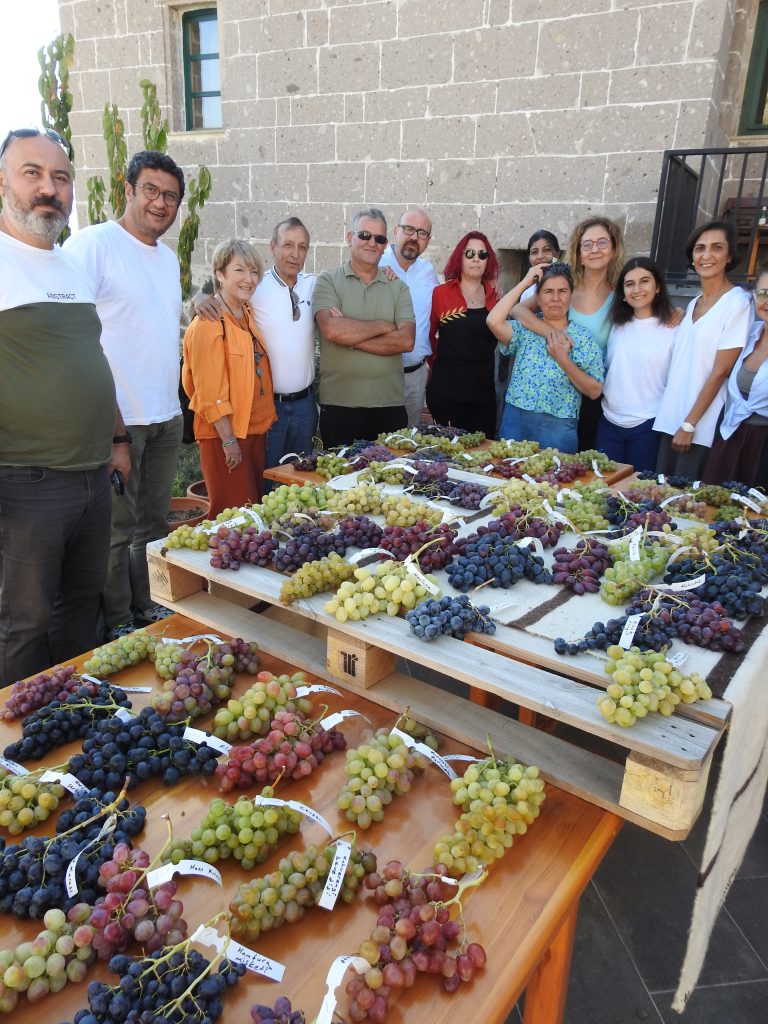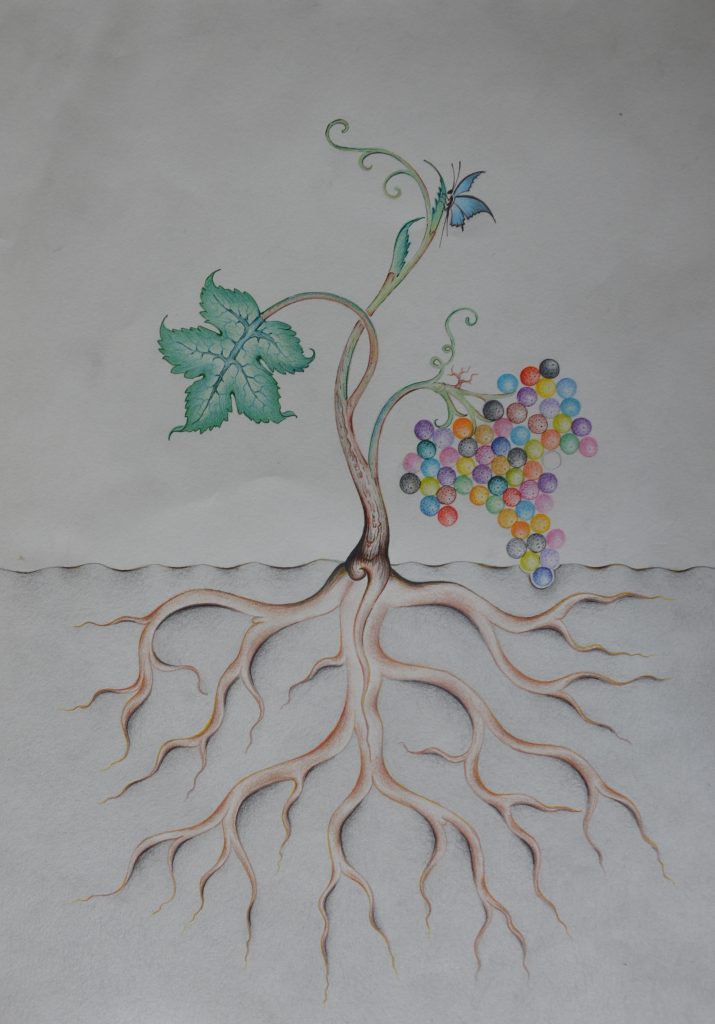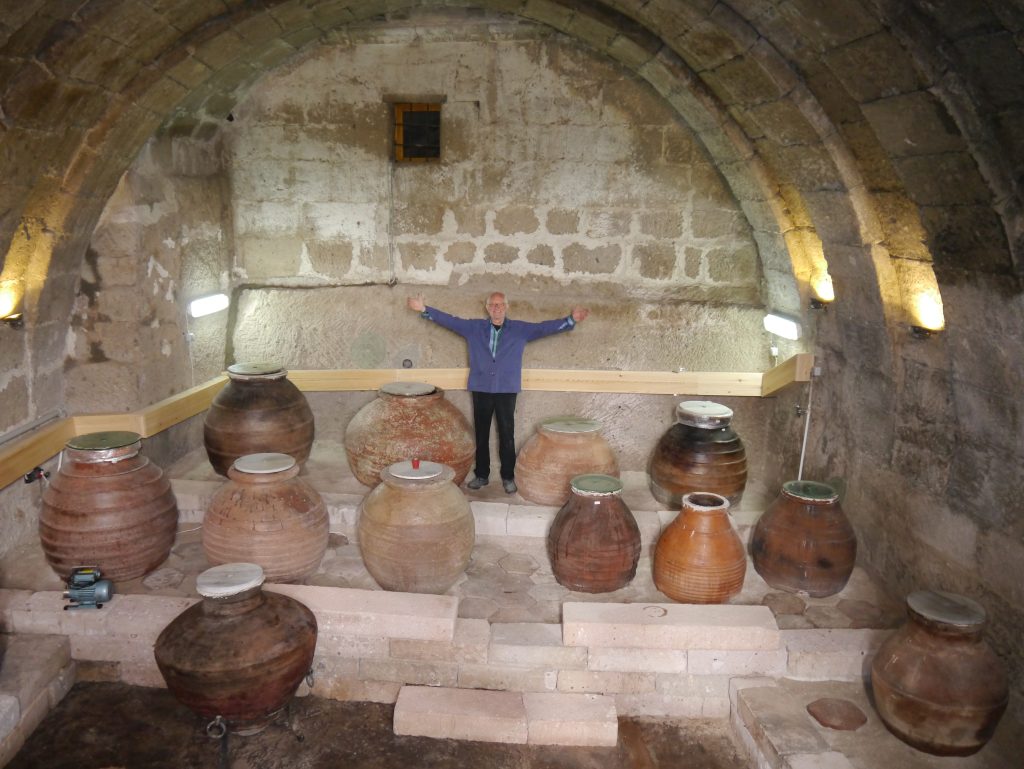
Cappadocia & Gelveri Manufactur
Cappadocia, Geology
The volcanic region of Cappadocia is located in central Anatolia between Kayseri and Aksaray and between the volcano Erciyes Dağı (3917 m) in the east and the volcano Hasan Dağı (3268 m) in the west. In the center of this volcanic landscape lies the village of Göreme with its unique rock formations and natural monuments and the fairy chimneys and tufa towers, which were added to the UNESCO World Cultural and Natural Heritage List in 1985. Intense volcanic activity has created this landscape. In the vicinity of the volcanoes Erciyes Dağı, Hasan Dağı of the Melendiz mountain range and between Kayseri, Aksaray and Niğde, significant eruptions occurred in geologically recent times. Lava and large quantities of volcanic ash were thrown into an area of several thousand km² and the landscape was completely reshaped by newly formed volcanic mountains and many layers of volcanic tuffs.

Fig. 1 The Hasan Dagi volcano , 3250 m altitude
Over the centuries, these layers of volcanic tuffs, formed by irregular eruptions, compacted into a relatively solid rock. Volcanic activity continued into historical times. In the 19th century, active fumaroles and smoke columns were reported from the Erciyes Dağı region near Kayseri, and there is still evidence of slightly active fumaroles at Hasan Dağı. After the volcanic eruptions, the valley landscapes of the later River Kızılırmak continued to expand, leading to sedimentary deposits of earths and clays. The pottery town of Avanos in particular benefited from these deposits. There are still around 120 potteries there today.
Cappadocia, wine history
Carbonized seeds and vine wood of the wild grape (Vitis vinifera sylvestris) were found in pre-pottery settlements in the northern Levant and in what is now south-eastern Turkey as early as 12000 BC. However, it was not until the Chalcolithic period, from around 5000 BC, that larger finds indicate the use and processing of grapes. It was also at this time that grapes began to be cultivated in the volcanic Cappadocia. In the subsequent Early and Middle Bronze Age, there is an increasing number of written references to wine production. Many come from the excavations at Kanes and Kültepe and other excavations in the east, but also from Acem Höyük in western Cappadocia and from Karahöyük near Konya. Many of these writings are extensive and detailed. (Barjamovic and Fairbain, Gorny ect.). In the land of Lukka in southwest Anatolia, which was under the influence of the Hittites, there was the city of Winuwanda in the 14th century BC, which means wine city. Later, in the Lycian language, Winuwanda became Oenoanda. At this time, wine was already being traded throughout the Mediterranean.

Fig. 2. Weather god Tarhunza
The rock relief of Ivriz from the 8th century. BC shows King Warpalawa and the storm and weather god Tarhunza, together with a Luwian hieroglyphic text. King Warpalawa of Tuwana stands on the right and greets the weather god Tarhunzas with raised hands. He is holding a bundle of wheat in his left hand and some grapes in his right as symbols of fertility. The particular fertility of this volcanic landscape in Cappadocia was probably understood very early on Cereals and pulses were cultivated in the lower areas and livestock, fruit and especially grapes were grown in the higher regions. On today, the aridity of the landscape does not seem very appealing. But the Cappadocian farmers and cattle breeders were able to gather experience over several thousand years and finally knew exactly what could be done where. And you can still see that now.
Phylloxera
Around 1860, a louse was accidentally introduced to France from America. This tiny animal, called Phylloxera vastatrix, feeds on the roots and leaves of grapevines. This pest destroyed large parts of viticulture throughout Europe. Many grape varieties were lost until a solution was found after decades of searching and research. As American vines have a certain immunity to the American phylloxera louse, European vines began to be grafted onto the rootstocks of American vines, not only in Europe but also among the official wine producers in Turkey. By 1920, a large proportion of the European vines still in existence were replanted on American rootstocks, and after the Second World War the rest of the grape varieties used for viticulture were replanted. Unfortunately, the wines from these grafted vines have irretrievably lost their original taste. Today, there are very few places where authentic vines still grow. This includes the phylloxera-free vines on their own rootstock in Cappadocia.

Cappadocia, the grape paradise
Fig.3. Cappadocian grape varieties
There are over 1435 grape varieties in Turkey, around 1200 of which have been ampelographically processed. This means that Turkey has an enormous genetic wealth. In the past, Turkish wine producers mainly produced wine with French and Italian grape varieties and only used endemic varieties with a few exceptions. On the Anatolian plateau at 800-1200 meters and in the mountainous zones between 1200-1600 meters, old varieties still grow in historically known wine areas in some regions of Anatolia. In the villages, almost every family has a grape garden (bağ) with 6-10 different grape varieties, which are processed and consumed according to need and tradition. In addition to wine, Turkey produces raisins, pekmez (syrup), grape juice, rakı, vinegar and vine leaves, as well as a variety of different sweets and desserts for trade. The tradition of this diverse use has contributed to the fact that many grape varieties have been preserved on their own rootstock in Turkey.

Traditional forms of vine cultivation
fig 4. Vine yard near Sinassos
The volcanic landscape often only allows for simple gardening and small-scale agriculture, and sheep and goat farming in the mountainous areas. There are no intensively farmed areas at these altitudes of 800 to 1600 meters. The tuffa landscape is a natural landscape, rich in minerals and with a high level of biodiversity. In this Cappadocian landscape, various methods have been developed for the cultivation of vines, which are still used today. They are regarded as evidence of a millennia-old cultural landscape with adapted grape-growing methods. Professional wineries and their vineyards are normaly established at low altitudes. At higher altitudes and around many villages, however, there are many small fruit and grape gardens. They are usually no larger than 1 hectare. In such grape gardens, 6-10 different grape varieties grow and thus cover the needs of the respective owner family. The vines are cultivated in a goblet or bush form and, depending on the location, are protected and promoted using various growing methods against heat, cold and drought.

Fig. 5. Old gobelet vine
Cappadocia – Sustainable Use of Ungrafted Vines
Genetic wealth is an asset that is of great importance worldwide. In countries where an excess of chemicals has contaminated agricultural land for many decades and weakened it through huge monocultures, the production of healthy products has become increasingly difficult. Effective protection against increasing pests and diseases is hardly guaranteed any more. On the other hand, ecologically oriented cultivation methods and corresponding consumers have increased every year, but this has not halted the loss in the quality of life of the plants and the quality of their products. It is already very difficult to produce or find food on the market today that is not harmful to health in some way. It is possible to breed pest-resistant vines and thus reduce the need to use toxic pesticides. However, this can only be a first small step. The best solution is to plant original vines on unpoluted soil.

fig. 6. Our Logo „Cappadocia, Sustainable Use of Ungraftet Vines“
In the volcanic landscape of Cappadocia, there is exactly what is needed, namely healthy soil and a variety of grape varieties on their own rootstock. We have founded the association “Cappadocia “Sustainable Use of Vines on their own Rootstocks” and, together with many vineyard owners, want to preserve a larger number of rare grape varietiesthrough sustainable and economically viable use.
Our program includes the following work
– Cataloging existing grape varieties and stocks (approx.120 grape varieties) – Market analysis: Which traditional grape products can be marketed well, – Where are the best cultivation areas in Cappadocia and which of the traditional cultivation methods can be used, – Cooperation with tree nurseries, Çukurova University, Erciyes University, Niğde University, Ampelography, DNA, – Targeted cultivation of particularly rare vines (use-related), – Application of traditional processing methods for vine products, – Direct exchange of acquired knowledge and experience in cooperation with Cukorova and Ercies universitie – Support in the production of high-quality products and their sustanable marketing – Seminars, Pekmez Festival, Tasting and Talking and other activities to support and preserving the diversity of vines on their own rootstock, – Cooperation with European organizations, UNESCO recognition, Francs de Pied and others.
Cooperation with Gelveri Ltd, Sti. – Udo Hirsch / Hacer Özkaya,
Gelveri Manufacture is a small wine producer that was founded in 2008 in Güzelyurt/Aksaray with the aim of producing natural wines with local grapes. The best conditions for the production of good natural wines are found in the vineyards of Cappadocia. Particularly good locations can be found on the slopes of the Hasan Dagi volcano. The vineyards are located between 1300 and 1500 meters above sea level on the alluvial fans of the Hasan Dagi volcano. The deep tuff soil with a grain size of approx. 1-10 mm and occasional gravel is rich in minerals. There is a high level of biodiversity with a diverse flora. The annual rainfall is max. 300 mm, 5-7 months are without rain. Summer temperatures rise to +40 °C, winter temperatures fall to -20 °C . Some of our vines are up to 100 years old, others were planted a few years ago and are traditionally grown in gobelet form, as is customary locally. They all stand on their own root wood.In some years, a small amount of sulphite is sprayed once before the grapes bloom to protect them from mildew. Only newly planted vines are watered in the driest months of the first 3 years and fertilized with goat manure. For the harvest, the grapes are hand-picked and then separated from the stems in a mill. The mash is pumped into traditional clay vessels (Turkish Küp) with a capacity of 120-2000 liters. They ferment spontaneously with the grape’s own yeast. The resulting cap of skins and seeds is regularly mixed with the juice. After 8-14 days the Küps are sealed with red wine, and after 14 days to 3 weeks the Küps are sealed with white wine.

Fig. 7. The Gelveri Manufactur with old anatolian küps (clay yars)
After a maceration period of 4-6 months on the grape skins and seeds, we open the Küps again, taste the wine together with our friends and decide whether it should be bottled or whether we should decant it into other Küps and store it further. Our wines are bottled, corked and labeled unfiltered by hand. We produce atotal of around 6000 bottles of wine per year from 7 different local grape varieties. All vines grow on their own root stock and are healthy – we call our wines “Original & Natural”. Gelveri Ltd. Şti, is a member of the “Association Francs de Pied” and cooperates with the association “Cappadocia, Sustainable Use of Ungrafted Vines” and “Our old vine Türkiye”.
Udo Hirsch/Hacer Özkaya,
68500 Güzelyurt/Aksaray, Hasan Dağı Sok. 3-5
Tel: 0090 5559800345
Mail: udo.gelveri@gmx.de , hacer.gelveri@gmx.de